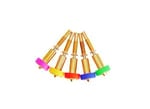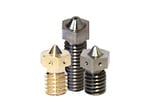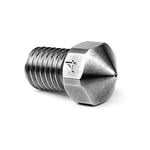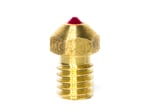There are so many things to consider when 3D printing; it’s almost overwhelming. We could go on and on listing the multitude of settings that need to be reviewed even before starting a print, not to mention the settings needed to achieve the best quality prints possible.
One setting that’s often overlooked is the nozzle. Yet, as the last part to be in contact with the filament, it has a significant impact on print time and quality. Selecting the correct nozzle is therefore an important step in improving your 3D printing skills.
Knowledge of different nozzles’ impacts on the overall 3D printing process is enough to send most of us makers off to the races. In this article, we’ll review the different nozzle options on the market and help you figure out which options are best for you.
The Importance of Nozzles
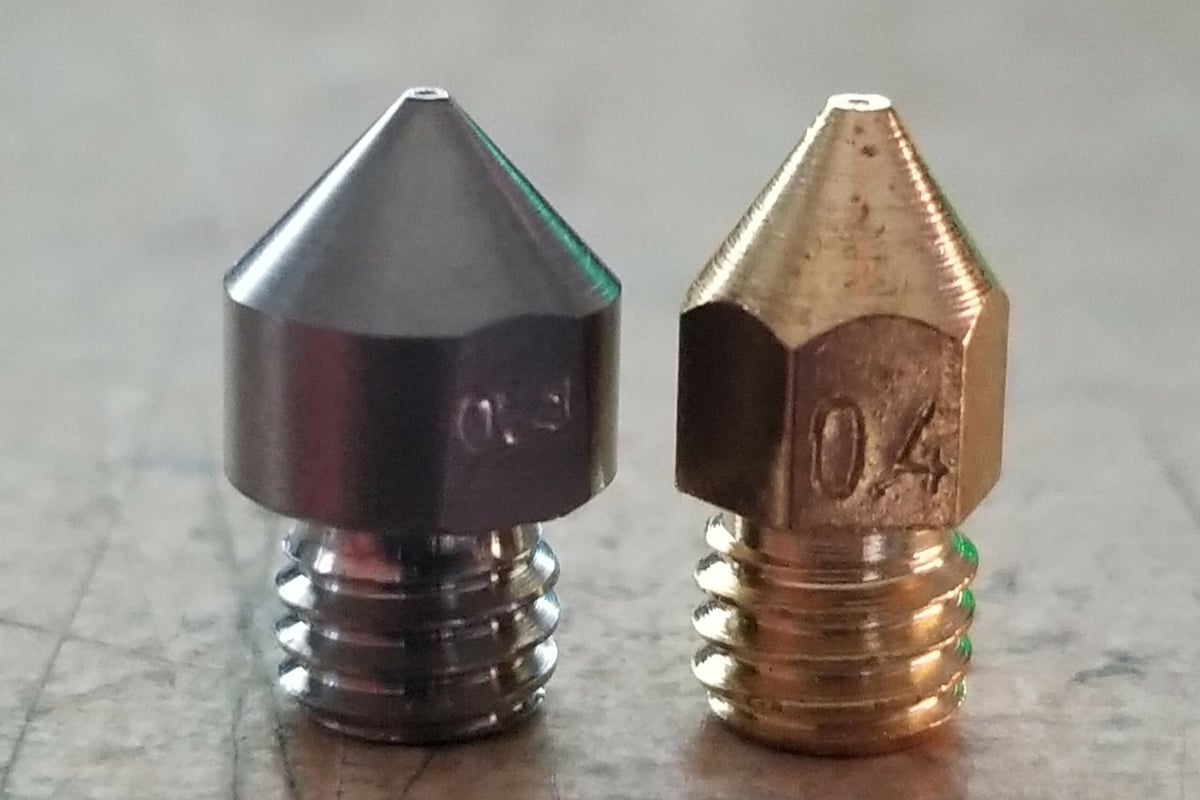
The nozzle is the mechanical part of the 3D printer that extrudes the filament. It conducts the thermal energy provided by the heating cartridge and block to the filament, melting it. Based on this information, it’s clear that three major characteristics are integral to a nozzle’s design: its size, material, and inner diameter.
The bigger the nozzle, the more mass and surface area available for transferring heat to the filament, making this process more effective and capable of higher extrusion speeds. Thermal conduction also relates to the nozzle material, as each material conducts energy differently based on its properties.
Lastly, the inner diameter of the nozzle affects the amount of plastic extruded per second, a property known as flow, which also determines the maximum extrusion speed. The inner diameter also relates to final part accuracy: Smaller diameters allow for thinner layers and walls to be printed.
In summary, all three nozzle characteristics can have a large impact on how long your part takes to print as well as the quality of the final object. Usually, a compromise between these two outcomes must be reached. In the next sections, we’ll detail each of these aspects separately and present a few designs available on the market.
Size
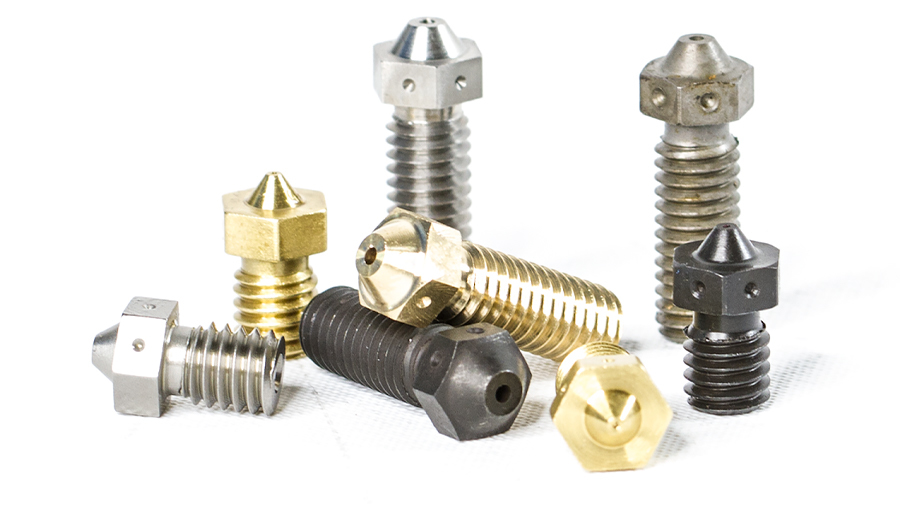
The overall size of a nozzle will determine how well it can heat up the filament during extrusion. By nozzle size, we mean the physical mass and length of the part. This should not be mistaken for the bore diameter, which is a measure of the inner space through which the filament is fed.
Standard
There aren’t that many different nozzle sizes available on the market, as the shaft length of the nozzle is dictated by the block type and size. The current standard dimensions for these parts comply with V6 hot ends and MK8 extruders, with a total length of 12 to 13 mm from the tip to the end of the M6x1 thread.
Volcano
The so-called Volcano hot ends are specifically designed for higher speeds and temperatures, with claims of processing at least three times more plastic than the regular V6 hot ends. For such reasons, Volcanos require a lengthier nozzle, usually 21 mm from end to end, to promote better thermal conduction.
SuperVolcano
The third size option, although rarely seen in stock 3D printers, is the SuperVolcano. As the name implies, it is an even longer version of the Volcano nozzle, measuring an almost ridiculous 50 mm in length. To handle such enormous dimensions, the heater cartridge is rated for 80W and can reach temperatures of 500 °C.
Material
Moving on, the next nozzle property on the list is the material. All nozzles produced today are made of some kind of metal due to its relatively high thermal conductivity and tight fabrication tolerances. With that said, different metals are used in nozzle fabrication. Each has unique properties, which influence the 3D printing process in different ways. Let’s talk about some of the most popular materials.
Brass
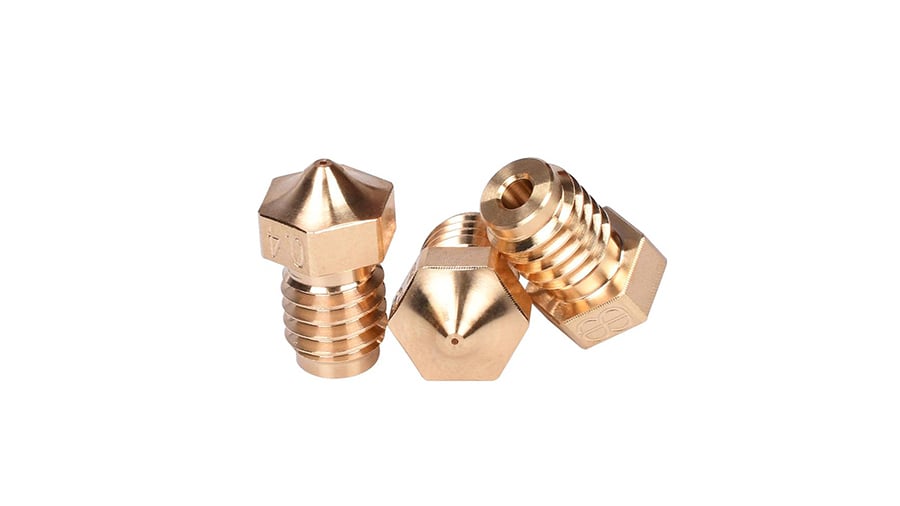
Brass is by far the most common metal used for 3D printer nozzles. This copper-zinc alloy offers great heat transfer at a relatively low cost. However, while these nozzles tend to be inexpensive, brass isn’t the most resistant material and is highly vulnerable to wear.
Brass nozzles can deteriorate externally from every bump or scrape that might happen during the 3D printing process. Even though this is not immediately noticeable, the wear and tear builds up slowly over time, which can truly compromise important external dimensions of the nozzle.
Special 3D printing materials like carbon fiber and metal-filled filaments contain abrasive particles that can ruin the nozzle’s internal surfaces if used regularly. A damaged internal bore can compromise print quality, and the catch is, this erosion is virtually impossible to spot and diagnose. For this reason, brass nozzles are better used for printing non-abrasive materials.
Stainless Steel
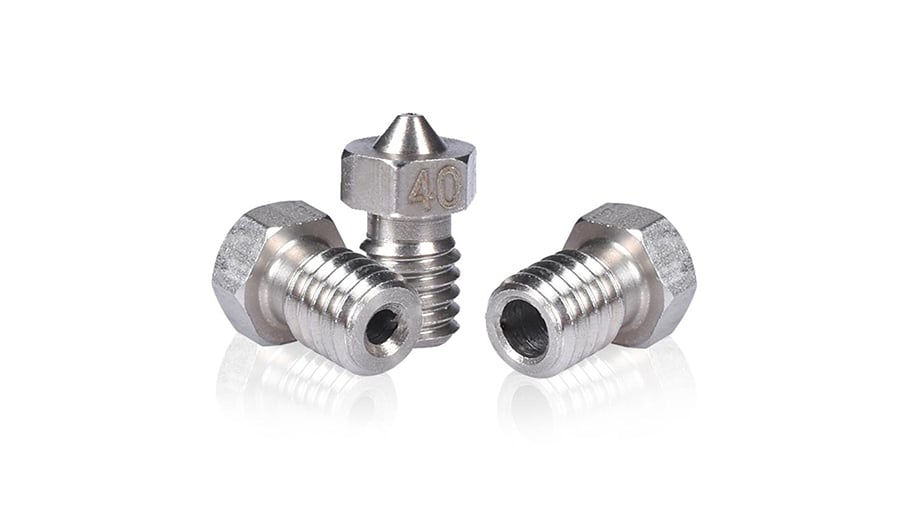
Stainless steel is another popular material used in nozzles, as it provides a slightly better wear-resistance than its brass counterparts. They also prevent, to some degree, melted plastic from getting stuck to its surfaces, keeping it tidier.
These nozzles don’t contaminate the print with lead, which can occur with brass nozzles. Stainless steel nozzles can therefore be suitable for food-grade materials with the proper precautions.
Stainless steel allows for a wider variety of filaments, but is still not recommended for heavy usage of abrasive materials. It’s also less thermally conductive in comparison to brass.
- Maximum temperature: 500 °C
- Best used with: Non-abrasive filaments and light use of abrasive materials such as NylonX, carbon fiber, glow-in-the-dark, metal-filled, wood-filled, and ceramic-filled filaments
Hardened Steel
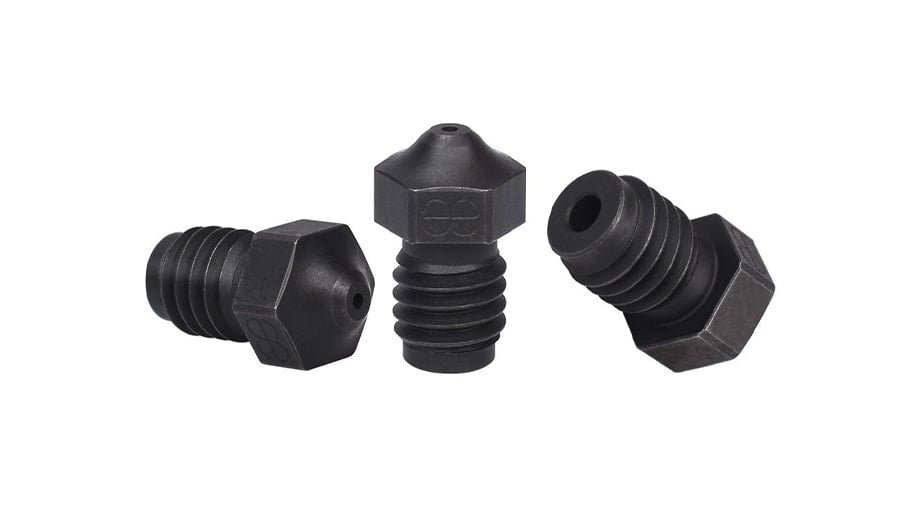
Hardened steel nozzles are a major upgrade, as they’re tough enough to handle frequent use of abrasive materials and offer literally years of use without replacement. However, this material has an even lower thermal conductivity than the previous two materials and takes longer to achieve the target temperature.
Being such a hard metal, some claim that its internal surface is not as smooth as other “softer” materials, possibly leading to lower quality printing. Please consider all of the above before committing to these nozzles, as they’re also more costly than the regular ones.
- Maximum temperature: 500 °C
- Best used with: All materials, including heavy use of abrasive materials
Assembled Nozzles
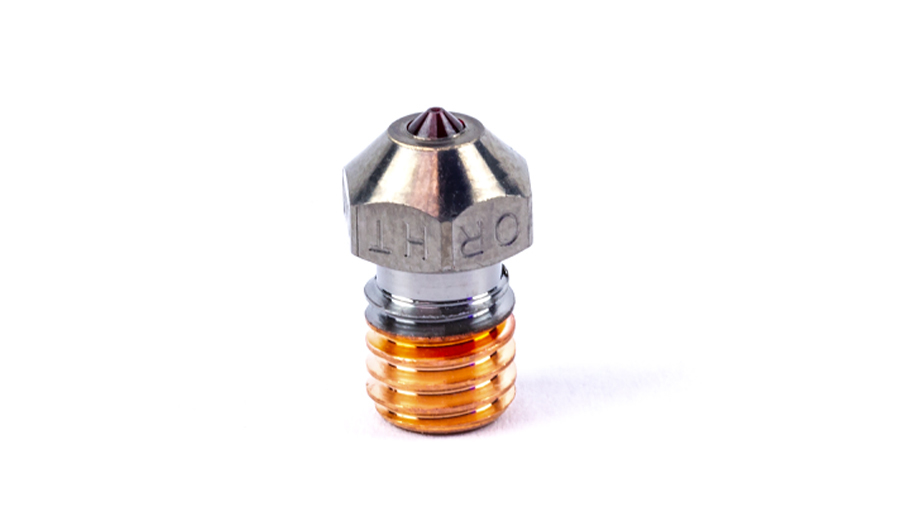
Assembled nozzles are made from two separate parts that are joined together, each one made of a different material to leverage the best properties of each. We’ve already seen that some materials – hardened steel, for example – offer less thermal conductivity, even though they are highly durable.
Assembled nozzles usually have a bulk material with great heat transfer properties, while the inner part that makes contact with the filament has durable and abrasion-resistant properties. The idea is to have the best of both worlds in one single nozzle.
These special nozzles are specifically recommended for high-temperature applications and materials such as PEEK and carbon fiber filament. As we’ll see later, some of these nozzles include high-grade materials like ruby. Needless to say, assembled nozzles are far more expensive than regular brass and stainless steel varieties.
- Maximum temperature: High temperatures, but the exact maximum temperature varies between models
- Best used with: All materials, including heavy use of abrasive materials and engineering plastics like PEEK and Ultem
Bore Diameter
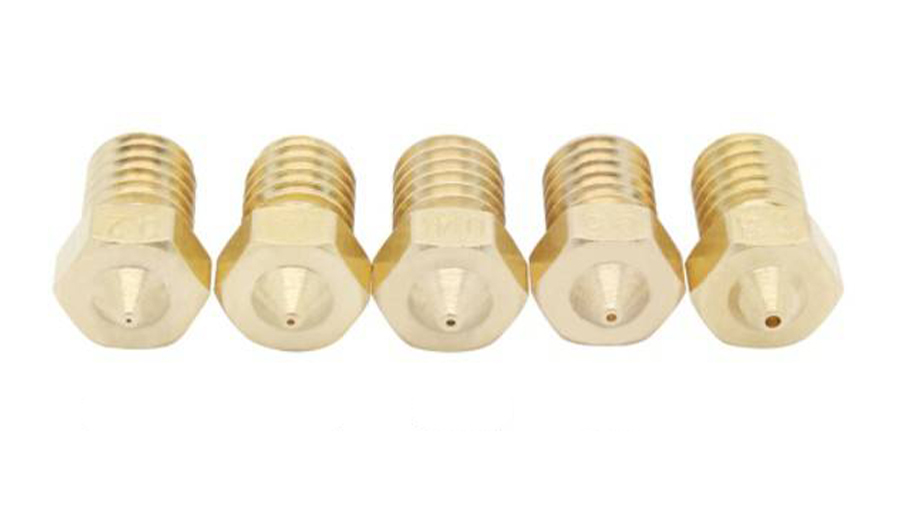
The final and perhaps most delicate nozzle characteristic to consider is the internal bore diameter. Nozzle diameters generally range from 0.1 mm all the way up to 1.0 mm. This gives the 3D printer user a great degree of flexibility. With so many options, which one is the one to go with?
In the end, it’s all about balancing how much filament is extruded and how fast. The absolute standard in 3D printers today is the 0.4-mm nozzle, which is found in almost all popular machines. This diameter provides a great balance between speed and precision.
It’s worth noting that the recommended layer height range is somewhat dependent on the nozzle diameter. As a general rule, the maximum layer height values should not exceed 80% of the nozzle diameter. For example, a 0.4-mm nozzle has a recommended maximum layer height of 0.32 mm.
It goes without saying that larger nozzles will extrude more material through thicker layer heights and widths. On the other hand, smaller nozzles (less than 0.4 mm) can yield amazingly detailed prints with barely visible layer lines. Unfortunately, it comes with a reduction in print speed and an increased possibility of clogging since the bore diameter is so small.
Larger Nozzles (> 0.4 mm)
- Reduced print time
- Fewer nozzle-related print errors
- Recommended for abrasive material (less prone to clog with particles)
Smaller Nozzles (< 0.4 mm)
- Higher precision
- Higher quality overhangs
- Supports are easier to remove
Options

Now that we’ve covered the most important aspects of nozzle design, let’s take some time to review some well-known models available on the market today.
E3D
E3D, a British manufacturer of hot ends (and other 3D printer parts) operates as an open-source hardware company, which in turn “inspires” most other manufacturers to follow their designs, including its nozzles.
As of today, E3D offers nozzles for V6, Volcano, and SuperVolcano hot ends in the following materials: brass, stainless steel, hardened steel, plated copper, and nickel-plated hardened tool steel. The last of these is marketed as Nozzle X. Internal bore diameter sizes vary but often range from 0.15 to 0.8 mm.
E3D’s lineup of Revo nozzles looks to make swapping between nozzle sizes as simple as possible with an all-in-one heatbreak and nozzle combo. You won’t need to worry about tools or tightening with these hassle-free nozzles. The different nozzle sizes can be distinguished at a glance due to their color-coded silicone socks.
MatterHackers
Another big company in the 3D printing business, MatterHackers has its own line of CleanTip nozzles. These nozzles are available in brass and stainless steel, both coated with Tungsten Disulfide for frictionless and easier cleaning. Sizes vary, covering most hot ends and 3D printers around and with inner diameter options from 0.25 to 1.20 mm.
Micro Swiss
Micro Swiss is yet another popular 3D printing company located in the US. What most people don’t know is that they started as a manufacturer of brass nozzles.
The American company now works with three different materials: basic brass, A2 hardened tool steel – both with a wear-resistant special coating – and their M2 high-speed steel-plated nozzle, designed to withstand abrasion in high-temperature applications. Sizes vary depending on the material and model but are generally in the range of 0.2 to 1.2 mm.
Slice Engineering
Slice Engineering is mostly known for its sophisticated hot end designs like the Mosquito and, more recently, the Copperhead. Their Vanadium nozzle is made from vanadium-alloyed high-speed steel for greater abrasion resistance and high-temperature printing. This nozzle is available only in a short version (i.e. V6-style) in bore diameter sizes from 0.2 mm to an incredible 1.8 mm.
Two of their newest nozzle options include the BridgeMaster and the AP3X. The BridgeMaster nozzle is designed for optimal temperature control, utilizing a copper alloy for thermal conductivity. This nozzle looks to improve bridging capabilities for your printer, with standard bore diameters of 0.2 mm up to 1.8 mm.
As Slice Engineer’s entry to the world of belt and non-planar printing, the AP3X is designed with an extended nozzle length to better suit these types of 3D printers. They have Vanadium and BridgeMaster variants available, each with bore sizes ranging from 0.4 mm to 0.8 mm.
Bondtech
Bondtech is well-known for its innovative filament feeders and extruders, allowing 3D printers to print much faster than typical stock parts. Their recent lineup of nozzles has also become a hit with the community, especially those looking to increase flow rates.
The company’s popular CHT line of nozzles utilizes a three-chamber approach that cuts into filament and melts it from the inside. This method melts filament much faster than a traditional nozzle and leads to increased flow rates for faster printing speeds.
The brass nozzle is manufactured in many different sizes, with nozzles available for most of the popular 3D printer formats. You’ll find bore sizes ranging from 0.4 mm up to a traditional 1.8 mm.
Their Bi-Metal CHT nozzles utilize a combination of a copper body with a hardened steel insert to quickly reach desired temperatures and maintain them while printing abrasive materials. These nozzles are available with 0.40-mm, 0.60-mm, 0.80-mm, and 1.0-mm bore sizes.
3D Solex
This Norwegian manufacturer has provided the commercial 3D printing community with some much-needed UltiMaker hot end upgrades and Prusa nozzle replacements. Their newest 3D printing nozzles promise long-lasting durability at a fair price.
Originally designed for Google, 3D Solex’s Print Core Everlast Ruby Sapphire offers one of the toughest nozzle tips on the market, allowing you to print all kinds of abrasive and exotic filaments without worrying about nozzle wear. They also have CHT-style variants available for faster flow rates.
You will find a good selection of bore sizes, with 0.25 mm, 0.40 mm, 0.50 mm, 0.60 mm, 0.80 mm, and 1.2 mm available.
Olsson
Olsson has been praised by much of the community for their commitment to cutting-edge designs in the 3D printing space. Their nozzles sport some remarkable features, such as 500 °C printing temperatures and compatibility with many common nozzle options, including V6 and MK8-style nozzles.
The Olsson Precision Nozzle boasts micron-level tolerances that should maintain its intended bore size much longer than traditional nozzles. The hybrid NEDOX coating prevents hot filament from sticking to the nozzle as it travels, reducing blobs and stringing. You can expect only a few options for bore sizes, including 0.4 mm and 0.6 mm.
Last but definitely not least, here’s a well-known nozzle that could be considered a piece of jewelry: the Olsson Ruby. The bulk material of the nozzle is brass, but it features a ruby tip for extra wear resistance. The company also offers a high-temperature version of this nozzle in a copper alloy, which can withstand temperatures up to 500 °C. The nozzle comes in different sizes and bore diameters of 0.4 mm, 0.6 mm, and 0.8 mm. At ~$90 apiece, this is truly a gem.
What's the Best Nozzle?
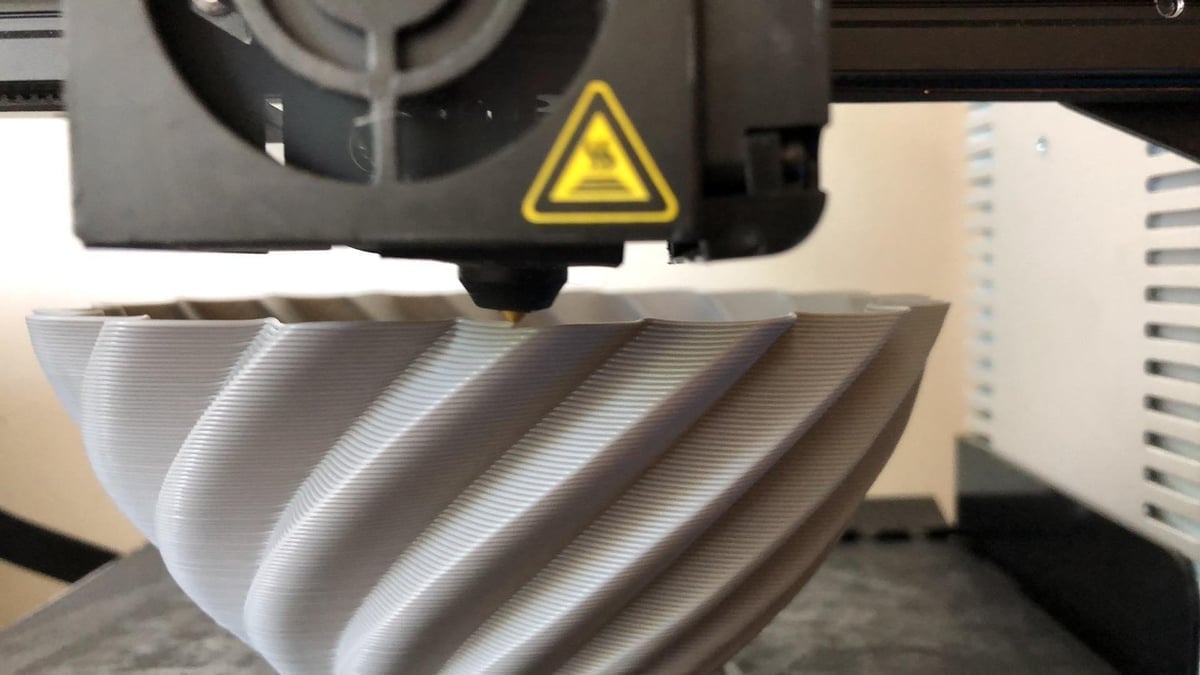
As you can see, it’s very important to give serious thought to which nozzle you’re using. Understanding the advantages and disadvantages of different nozzle designs and materials can greatly improve your machine’s performance and the quality of your prints.
So which nozzle is the best? That’s up to you to decide. It comes down to your particular printing setup, the array of materials you print with, and whether you’re more willing to compromise on quality or speed.
License: The text of "Best 3D Printer Nozzle: Types, Sizes & Materials" by All3DP is licensed under a Creative Commons Attribution 4.0 International License.
CERTAIN CONTENT THAT APPEARS ON THIS SITE COMES FROM AMAZON. THIS CONTENT IS PROVIDED ‘AS IS’ AND IS SUBJECT TO CHANGE OR REMOVAL AT ANY TIME.



